An evil is coursing through the veins of America.
More than 28,000 people died as a result of heroin or illicit prescription drug-related overdoses in 2014—more than any year on record and a one-year increase of nearly 15 percent.
The number of heroin- and prescription drug-related deaths is reaching “levels similar to the HIV epidemic at its peak,” nearly tripling over the last five years. And now, the Obama administration is changing federal regulations to make it easier for healthcare providers to use anti-addiction drugs and to expand the number of patients a physician can treat. The initiatives come as at least 15 states grapple with an escalation in heroin overdoses.
President Barack Obama, who attended a national addiction summit in Atlanta on Tuesday, has proposed an additional $1.1 billion in new funding aimed at arming states with the ability to purchase prevention drugs and to train health providers and first responders.
Hundreds—including individuals in recovery, medical professionals and members of law enforcement—convened at the National Rx Drug Abuse & Heroin Summit. The summit, focused on fighting the prescription painkiller and heroin overdose epidemic, featured a panel hosted by the president and CNN anchor Sanjay Gupta, who is an Atlanta neurosurgeon. The audience heard directly from two recovering addicts, who spoke candidly about how they fed their addiction, its impact on their families, and their fight to get clean.
The White House also said $94 million in new federal funding will be used to expand medication-assisted treatment at over 250 health centers in targeted communities. The administration is directing another $11 million in funding to state governments for the purchase of naloxone—a medication used to reverse overdoses—and to train first responders to use it effectively.
Overdose deaths from opioids are the leading cause of unintentional death for Americans. According to the Centers for Disease Control and Prevention, opioid overdoses claim a life every 19 minutes. In states like New Hampshire, Massachusetts, West Virginia, and Oklahoma, the proposals may help stanch the tide of addiction and overdose. Known as skag, horse, or smack on the street, the relatively low cost of heroin is part of the reason for the surge in use.
Local and federal officials are particularly worried about the proliferation of fentanyl, a fact-acting, extremely potent pharmaceutical often used by dealers to “cut” or dilute heroin. The synthetic narcotic, used to prevent pain after surgery, is now being trafficked as a stand-alone drug and is 100 times more powerful than morphine.
The president also announced a list of additional measures. Among them were greater access to mental health and drug addiction therapy, through both Medicaid and the Children’s Health Insurance Program (CHIP), for more than 23 million people. The new coverage parity regulations are an expansion of the Mental Health Parity and Addiction Equity Act of 2008. That law requires group health plans to equalize co-pays, deductibles and treatment limitations with all medical and surgical benefits.
Dr. Leana S. Wen, commissioner of the Baltimore City Health Department, said criminalizing addiction is a mistake. However, in a particularly candid moment, President Obama raised the issue of income and race as historical barriers to reform. Addiction, the president said, was treated as a moral issue but that stigma is changing because the face of the victims is changing.
Justin Lake Riley, who joined the president’s panels, says his addiction began as a child with an over-the-counter medication. Struggling with feelings of inadequacy, he used Benadryl to sleep and, when that wasn’t enough, he turned to harder drugs. Riley is president of Young People in Recovery.
“People can and do recover,” he told the audience.






